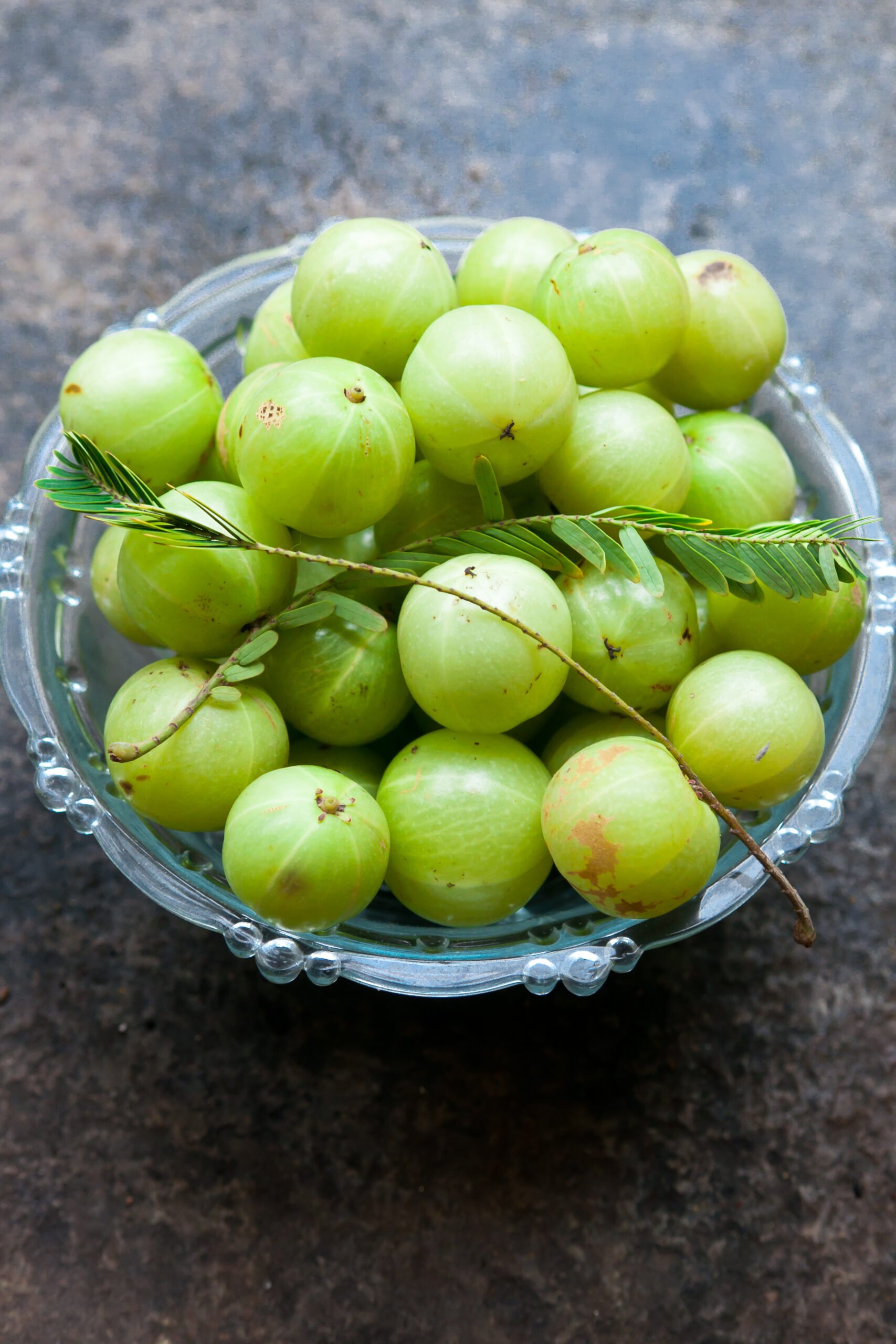
What grows on a tree, tastes a little like a dare, makes your hair shine, supports digestion, boosts immunity, and even helps your skin glow?
Not a miracle supplement — just Amla.
Also known as Indian gooseberry, this small green fruit has been quietly doing it all for centuries. From traditional hair oils to modern immunity shots, Amla has moved from old kitchen remedies to the shelves of wellness stores without ever losing its charm.
Here’s a closer look at why this ancient fruit still earns a place in daily life — whether it’s in your food, your morning tonic, or your hair care routine.
What Is Amla, Exactly?
Amla is a small, round green fruit that grows on the Emblica officinalis tree. It’s been a staple in Ayurvedic practices for over 3,000 years, often hailed as a symbol of rejuvenation and longevity.
What makes Amla stand out is how seamlessly it blends into every corner of life: health rituals, beauty routines, kitchen recipes, and traditional remedies.
Whether it’s tucked into a wellness shot, stirred into herbal oils, or sun-dried into chewy candies, Amla’s been showing up—and staying relevant—for generations. Simply put, it’s one of those rare ingredients that bridges ancient wisdom with modern-day wellness goals.
Quick Facts – Amla (Indian Gooseberry)
- Scientific name: Phyllanthus emblica
- Common names: Indian Gooseberry, Amlaki, Nellikai
- Native to: India and Southeast Asia
- Flavor: Tart, astringent, slightly bitter
- Nutrient highlight: Exceptionally high in vitamin C and antioxidants
- Traditional uses: Boosts immunity, supports digestion, promotes hair and skin health
- Common forms: Fresh fruit, dried powder, juice, or pickled
- Best paired with: Honey, ginger, turmeric, or in chutneys and herbal tonics
- Fun fact: In Ayurveda, amla is considered a “Rasayana” — a rejuvenating food for longevity.
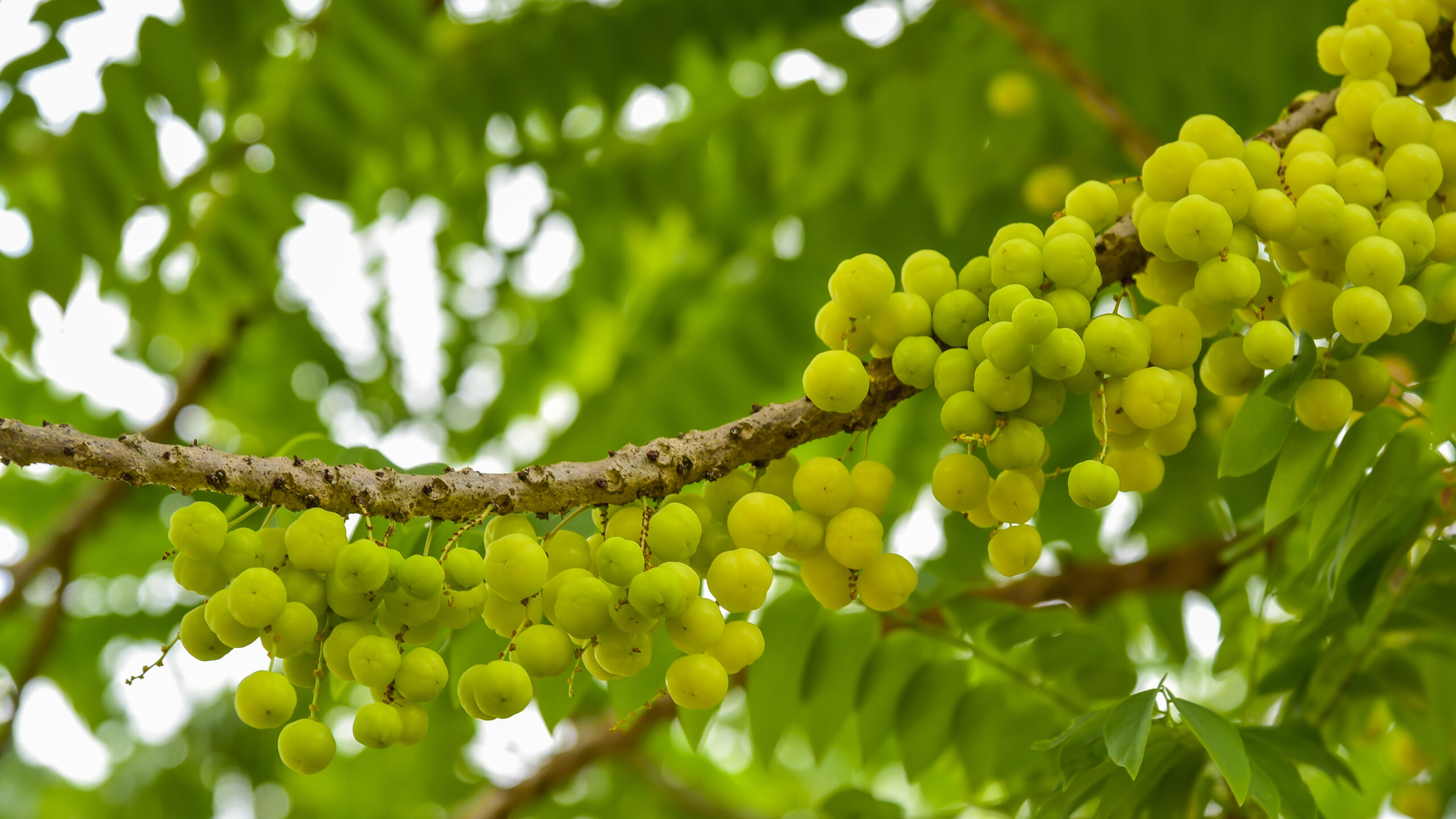
Amla in its natural habitat—native to India and parts of Southeast Asia, ripening on the Emblica officinalis tree.
Forms You’ll Find It In
Amla isn’t a one-trick fruit, it shows up in more forms than you might expect. Whether you're eating it, sipping it, or slathering it, here’s where you’ll spot it:
Fresh Amla
Found in local markets during its season; raw, bright green, and super tart; used raw, juiced, or for pickling.
Dried Amla
Sun-dried or dehydrated slices, usually chewy or slightly crispy. Sometimes coated in jaggery or spices for a sweet-and-sour snack.
Amla Powder
Finely ground dried Amla, packed with versatility. Stir it into water, teas, smoothies, face masks, or hair oils.
Amla Juice
Bottled and often blended with herbs like tulsi, ginger, or aloe vera. Used as a daily wellness shot or digestive tonic.
Amla Murabba
Soft, sweet preserves made by soaking Amla in spiced sugar syrup; served as a post-meal treat or morning boost.
Amla Oil
A go-to in natural haircare. Often mixed with other herbs and oils to nourish the scalp and promote healthy hair.
Amla Candy & Churan
Sweet, salty, or spicy versions meant for snacking or digestion.
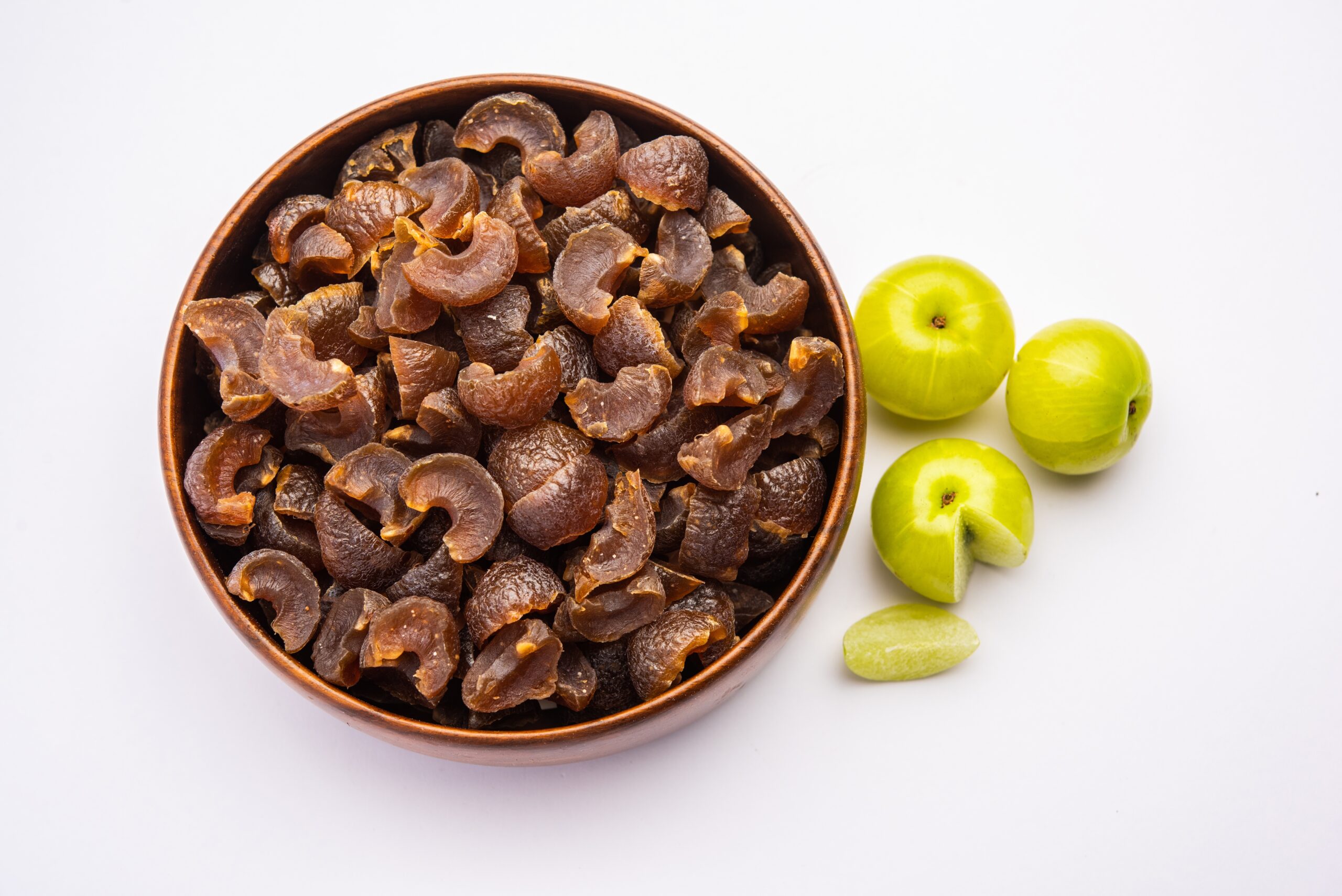
Dried Amla slices, nature’s tangy wellness booster, ready to snack or stir into recipes.
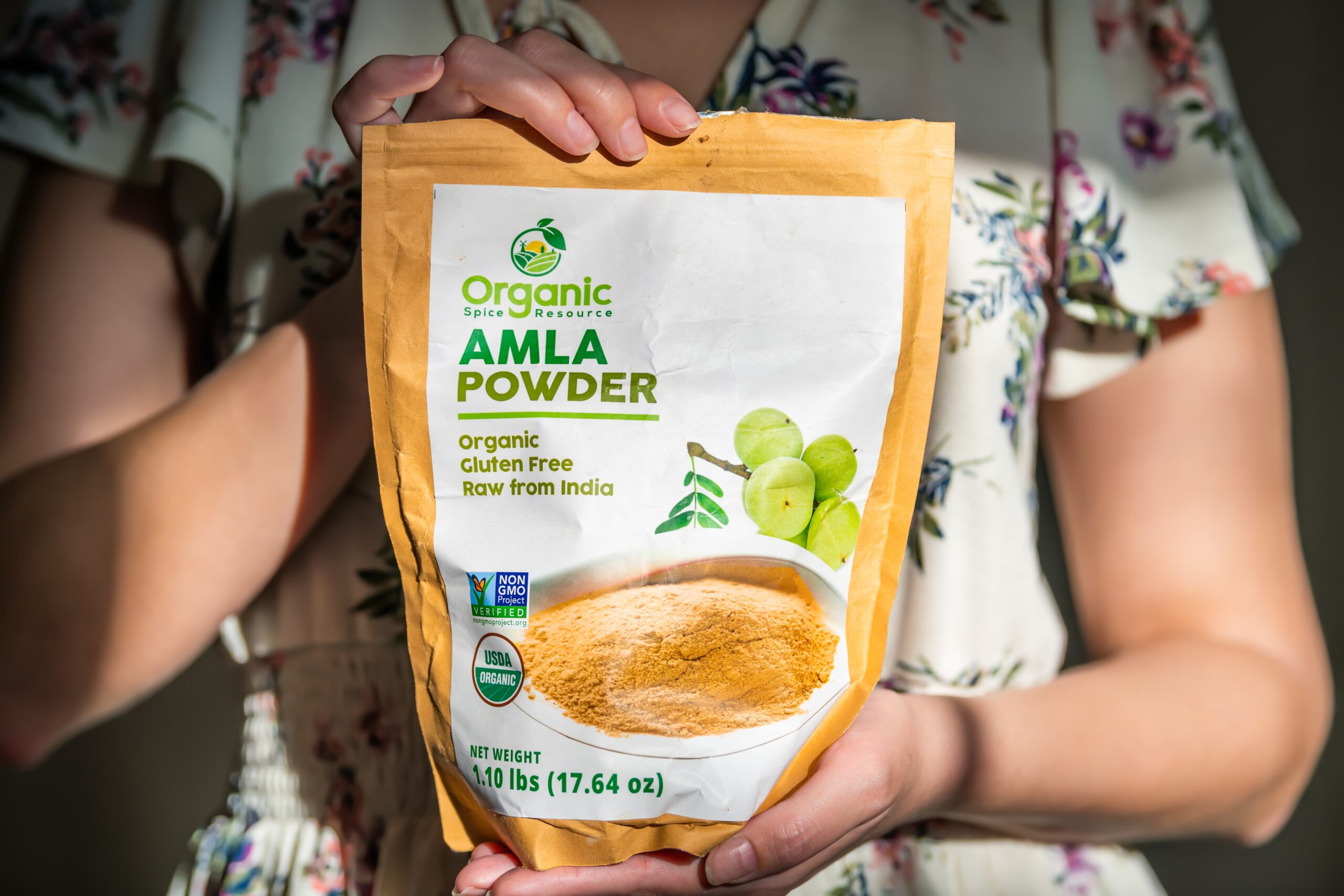
Amla powder; a fine, earthy superfood that fits into smoothies, masks, and herbal blends.
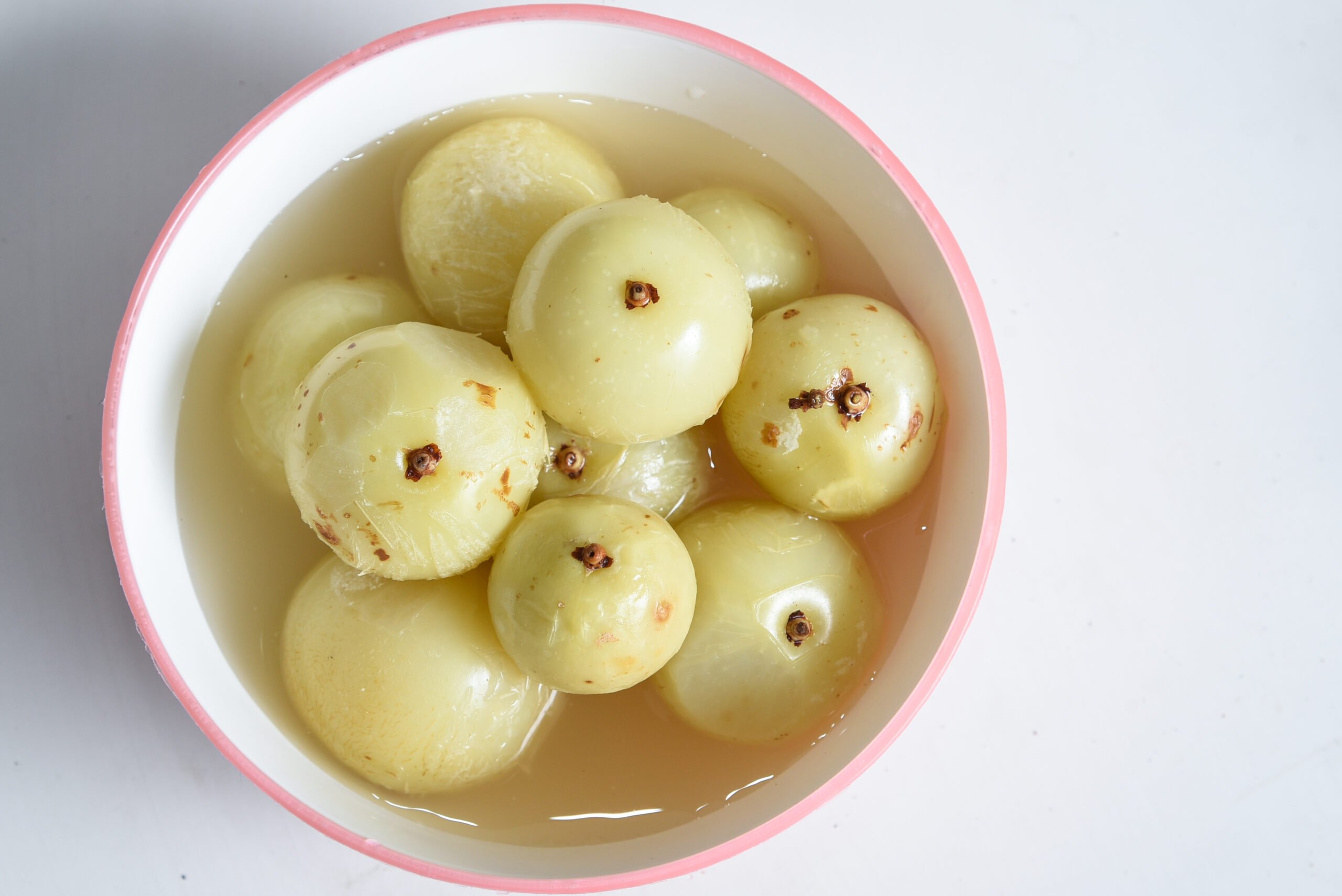
Amla murabba; sweet, syrupy, and packed with traditional goodness in every glossy bite.
Amla oil — the age-old secret to shinier hair and a happier scalp.
What Does It Taste Like?
One bite, and it hits you with a bold sour punch, sharp, intense, and borderline shocking if you’re not prepared. But stick with it. After the initial zing, something magical happens: a subtle bitterness, a hint of earthiness, and then a surprising, sweet aftertaste that sneaks in like a peace offering.
It’s a flavor rollercoaster, tangy, bitter, and oddly refreshing which is why it's rarely eaten plain. Most people pair it with honey, salt, spices, or jaggery to balance the sharpness and bring out its complexity.
Culinary Uses Around the World
From traditional meals to modern menus, Amla has quietly made itself at home in kitchens across cultures. Here’s how different parts of the world put this tangy powerhouse to good use:
India
-
Used in chutneys, curries, and rice dishes like nellikai sadam.
-
Made into murabba (sweet preserve) often eaten with meals.
-
Featured in pickles paired with mustard seeds, oil, and spices.
-
Stirred into Ayurvedic tonics and herbal concoctions.
Other South Asian Regions
-
In Nepal and Bangladesh, Amla is often fermented or pickled with regional spices.
-
Consumed as part of post-meal digestive mixes and tangy spice pastes.
Global Wellness Kitchens
-
Added to green juices, immunity shots, and smoothies for a health boost.
-
Infused into herbal teas or wellness elixirs.
- Used in fusion cooking, such as citrus-forward dressings or chutney-glazed vegetables.
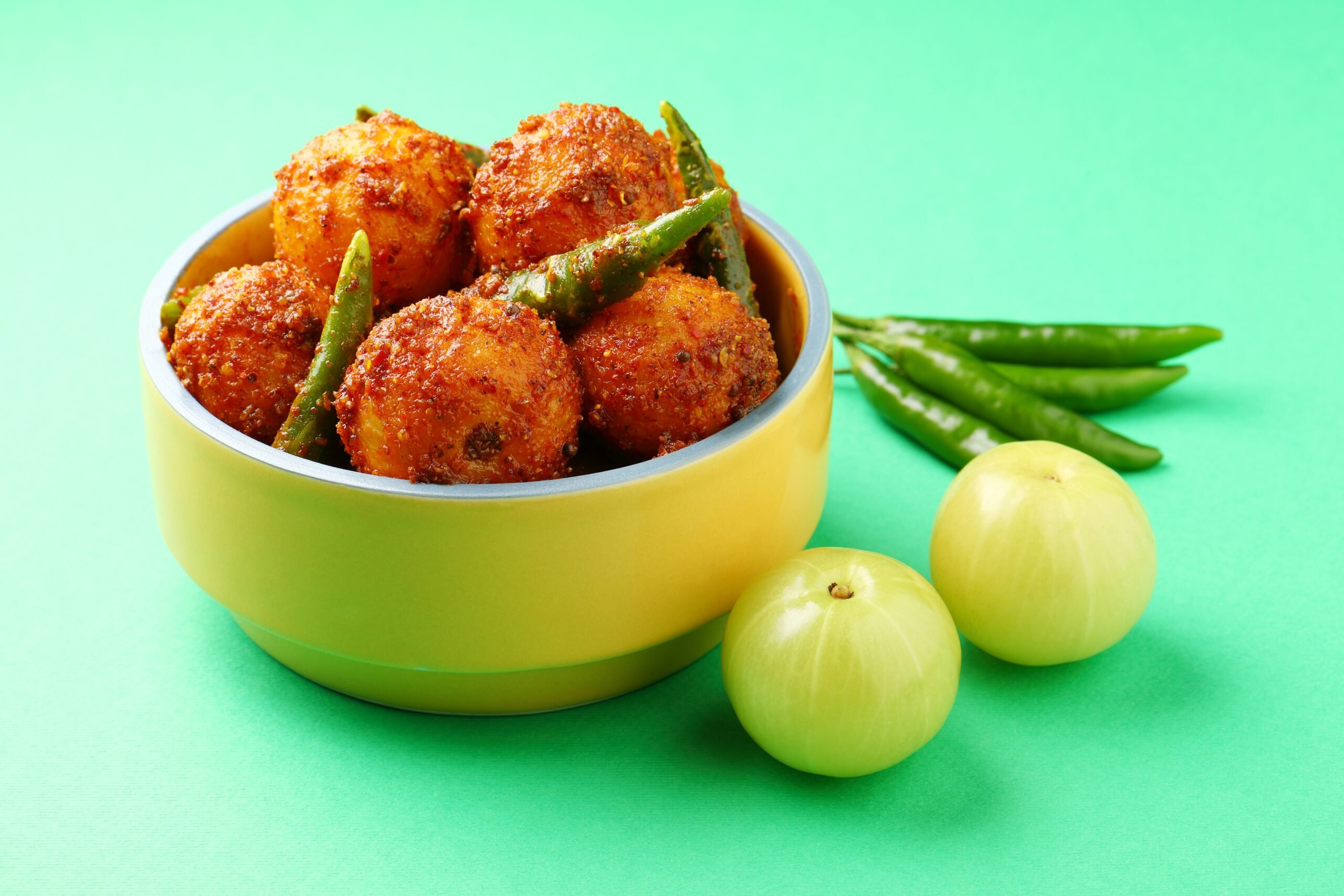
Amla pickle; tangy, spiced, and bursting with traditional flavor and gut-friendly goodness.
Creative Ways to Use Amla Beyond Traditional Recipes
Sure, Amla has deep roots in traditional cooking, but it’s not afraid of a little modern flair. If you’re looking to break out of the usual chutneys and pickles, here are some fun and unexpected ways to invite this sour superstar into your everyday routine:
-
Add it to smoothies – Blend a spoon of Amla powder with banana, spinach, and ginger for a tangy wellness kick
-
Whisk it into salad dressings – Amla juice or powder adds a bold citrus twist to vinaigrettes
-
Mix into dips and spreads – Stir into hummus, guacamole, or Greek yogurt with a dash of cumin and salt
-
Use in tea infusions – Simmer dried Amla with tulsi, cinnamon, or ginger for a warming herbal brew
-
Toss into energy balls or bliss bites – Combine Amla powder with dates, coconut, and nuts for a tart-sweet snack
-
Sprinkle on roasted veggies – A pinch of Amla powder with olive oil and sea salt gives carrots or sweet potatoes an unexpected tang
-
Blend into marinades – Use Amla as a souring agent in marinades for tofu, chicken, or paneer
Amla in Herbal Remedies and Wellness
In Ayurveda and other traditional systems, Amla is prized as a rasayana—a rejuvenator that may support overall balance and vitality.
-
Morning Ritual: Amla juice, often taken with tulsi or ginger, is believed to support digestion and liver health.
-
Part of Triphala: A key ingredient in this classic Ayurvedic blend for gut health and detox.
-
Digestive Support: Amla powder with warm water or ghee is used to ease acidity and promote regularity.
-
Cooling and Calming: Often paired with herbs like ashwagandha to balance internal heat and stress.
-
Unani Use: Traditionally used for blood purification and liver support.
-
Modern Wellness: Found in capsules, tonics, and immunity shots for daily use.
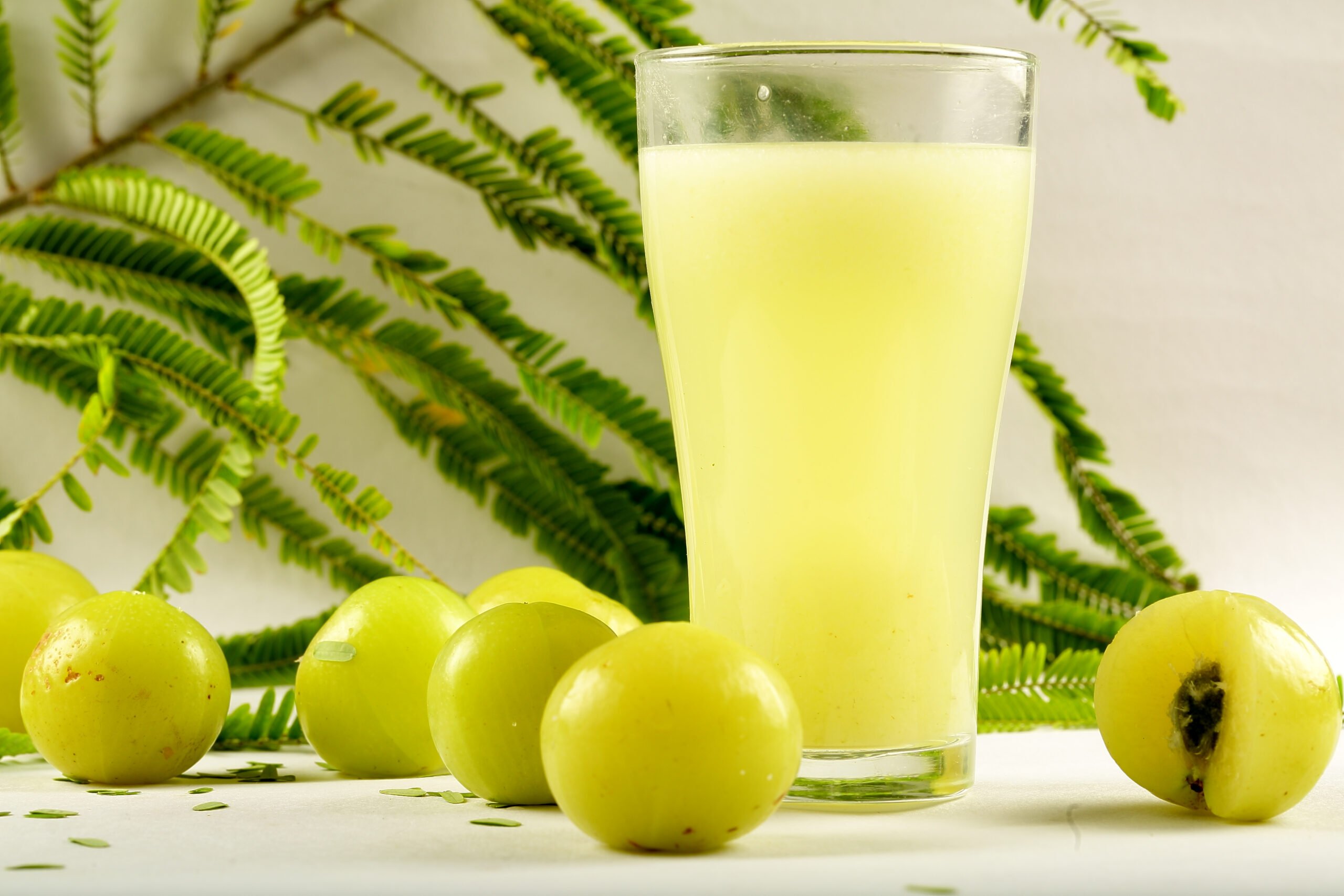
Amla juice — a zesty sip that may support immunity, digestion, and radiant skin.
Amla for Skin, Hair, and Natural Beauty
Amla has earned a long-standing spot in the natural beauty world — and not just because your grandma swore by it. Rich in antioxidants and Vitamin C, it may help your skin glow and your hair grow.
For Hair: Strength and Shine
-
Hair Growth Boost: Amla oil massages may help stimulate scalp circulation and reduce hair fall over time
-
Anti-Dandruff Remedy: Its antibacterial properties can help calm itchiness and flaking
-
Natural Conditioner: Mixed with henna or yogurt, Amla powder may leave hair soft and glossy
For Skin: Glow and Clarity
-
Brightening Effects: Amla’s high Vitamin C content may help fade dark spots and even out skin tone
-
Acne Support: Its antibacterial nature makes it useful in DIY masks for acne-prone skin
-
Anti-Aging Bonus: Antioxidants in Amla may help fight early signs of aging when used regularly
For an easy glow-up, mix Amla powder with rose water and apply as a 10-minute face mask. Rinse off for a fresh, toned feel — no harsh chemicals needed.
Flavor Pairings
Amla’s sharp, citrusy tang might seem tricky at first — but pair it right, and it turns into the hero ingredient you didn’t know you needed. Here’s what plays nicely with its bold personality:
-
Sweetness: Pair with jaggery, honey, or dates to mellow the sourness
-
Heat: Balances beautifully with green chilies, black pepper, or ginger
-
Earthy notes: Combine with cumin, carom seeds (ajwain), or turmeric for depth
-
Fruits & Herbs: Mix with lemon, mint, or coriander for refreshing blends
-
Bitters & tangs: Complements tamarind, kale, and methi (fenugreek) surprisingly well
Quick Tips to Get the Best Out of Amla
Cooking with Amla is easier than it sounds — you just need to know how to tame the tartness and pair it right. Here’s how to make the most of this bold little fruit in your kitchen:
-
Parboil or steam fresh Amla to mellow its sourness before using in savory dishes
-
Grate it fresh into chutneys, sauces, or stir-fries for a citrus-like zing
-
Balance the sharpness with jaggery, honey, or dates in sweet dishes and preserves
-
Add dried or powdered Amla into soups, lentils, or rice while cooking — a little goes a long way
-
Pair it with strong flavors like garlic, tamarind, mustard seeds, or green chilies
-
Start small if you’re new — even one fruit or a pinch of powder can shift a dish’s flavor
How to Store It Right
Amla’s shelf life depends on how you bring it home; fresh, dried, powdered, or juiced. Here’s how to keep each form at its best:
-
Fresh Amla:
Store unwashed in the fridge for up to 2 weeks. Keep it dry to avoid spoilage. -
Dried Amla:
Place in an airtight container away from moisture and heat. It’ll last for several months in the pantry. -
Powdered Amla:
Keep it sealed tightly in a cool, dark spot — ideally not near the stove or sunlight. Use within 6 months for best potency. -
Juice (Homemade or Bottled):
Refrigerate immediately after opening. Homemade versions should be consumed within 3–5 days. -
Amla Oil:
Store in a cool cabinet or drawer. Avoid direct sunlight to prevent it from going rancid.
Always use dry spoons when scooping out Amla products to avoid contamination.
Amla Substitutes
Can’t find Amla? No worries — while its unique sour-bitter profile is hard to replicate exactly, these substitutes come close depending on your use:
-
Lemon or Lime Juice
Great for tartness in recipes or wellness shots. Add a pinch of turmeric or ginger for an Ayurvedic twist. -
Tamarind Paste
Offers tang and depth in cooked dishes like dals or chutneys. -
Green Mango (Raw or Powdered)
Similar acidity and sharpness, especially in spice blends and pickles. -
Gooseberries (European varieties)
Milder but still sour — works well in jams, teas, and preserves. -
Bael Fruit or Hibiscus (for infusions)
Common in herbal teas where a fruity sourness is needed.
Remember: if you're using it for health purposes, these substitutes won’t offer the exact same benefits — but they’ll hold up flavor-wise in a pinch.
Nutritional Value (Per 100g of Fresh Amla)
Amla may be tiny, but it's surprisingly dense in nutrients. Here's what you’ll typically find in 100 grams of fresh Indian gooseberry:
-
Calories: ~44 kcal
-
Carbohydrates: 10–15g
-
Fiber: 4–5g
-
Vitamin C: ~600mg (more than 10x that of an orange!)
-
Calcium: ~25mg
-
Iron: ~0.3mg
-
Antioxidants: High levels of polyphenols like gallic acid and ellagic acid
Just one Amla a day may provide most of your daily Vitamin C needs.
Health Benefits of Amla
Amla isn’t just a traditional remedy — modern research backs up many of its time-tested uses. Here’s what this tart little powerhouse may offer:
It May Boost Immunity
Thanks to its extremely high Vitamin C content, Amla may help strengthen your body’s natural defense system (Source).
It Can Support Digestive Health
Amla may help improve gut motility and ease mild acidity due to its fiber content and mild laxative effect (Source).
It May Improve Heart Health
Some studies suggest Amla may help lower LDL (bad) cholesterol and reduce oxidative stress, both important for cardiovascular health (Source).
It May Help Regulate Blood Sugar
Amla has been studied for its potential to support healthy blood glucose levels by improving insulin response (Source).
It Can Protect Cells with Antioxidants
Rich in polyphenols and Vitamin C, Amla can help reduce cell damage caused by free radicals (Source).
It May Support Brain Function
Amla has been linked to improved memory and neuroprotection in animal studies, possibly due to its antioxidant effects (Source).
Potential Health Risks of Amla
While Amla is generally considered safe and beneficial, there are a few things to keep in mind — especially if you’re using it regularly or in concentrated forms.
It May Lower Blood Sugar Too Much
People taking diabetes medications should be cautious, as Amla may enhance their effect and lead to hypoglycemia (Source).
It Can Aggravate Cold or Cough
Due to its cooling nature, consuming Amla in excess — especially in colder weather — may worsen symptoms for some individuals (Source).
It May Interact with Medications
If you're taking blood thinners or heart medications, Amla might interfere with their effects, especially when consumed as juice or extract (Source).
It Can Cause Acidity in Sensitive Individuals
While it's known for aiding digestion, some people may experience mild acidity or gastric discomfort with raw Amla (Source).
Final Thoughts
Amla isn’t just a fruit — it’s a quiet powerhouse that’s been adding zing to recipes and glow to faces for centuries. Whether you’re tossing it into your lentils, mixing it into your face mask, or sipping it in your morning tonic, there’s something deeply grounding about this little green gem.
It may not boast bold colors or trendy buzz, but it delivers where it matters — flavor, nourishment, and tradition. Keep a little Amla in your kitchen or on your shelf, and you might just find it becomes a quiet favorite in your wellness routine.
FAQs
Can I eat raw Amla daily?
Yes, you can! Eating one raw Amla a day may support immunity but start small if you're new to its tangy taste.
What does Amla taste like?
Amla is intensely sour, slightly bitter, and leaves a dry, astringent feel in the mouth — definitely bold, but surprisingly refreshing.
Is Amla good for hair growth?
It may help! Amla oil is commonly used to support stronger roots, reduce dandruff, and promote shiny, healthy hair over time.
Can Amla help with digestion?
Yes, it may aid digestion thanks to its fiber and mild laxative effect. Many use Amla juice or powder for gut support.
How should I store dried Amla or Amla powder?
Keep them in an airtight container away from moisture and sunlight. Store in a cool, dry spot to maintain freshness.
Are there any side effects of Amla?
It’s generally safe, but it may cause acidity or lower blood sugar in some people. Best to start with small amounts.
Can I take Amla during pregnancy?
Small food-based amounts are usually safe but always consult your doctor before using concentrated forms like juice or supplements.
Learn More About Amla (Indian Gooseberry)
Healthline — Indian Gooseberry: Benefits, Uses and Side Effects
This article is exploring the uses of Amla (Indian gooseberry) across cooking and traditional medicine, detailing its potential benefits for immunity, digestion, heart, liver, and hair health while also highlighting safety precautions.
WebMD — Health Benefits of Amla
This article covering the potential health benefits of Amla (Indian gooseberry) including its antioxidant-rich profile that may help reduce risks for heart disease, diabetes, and cancer—while also noting possible side effects like mild digestive upset and interactions with medications for individuals with certain health conditions.


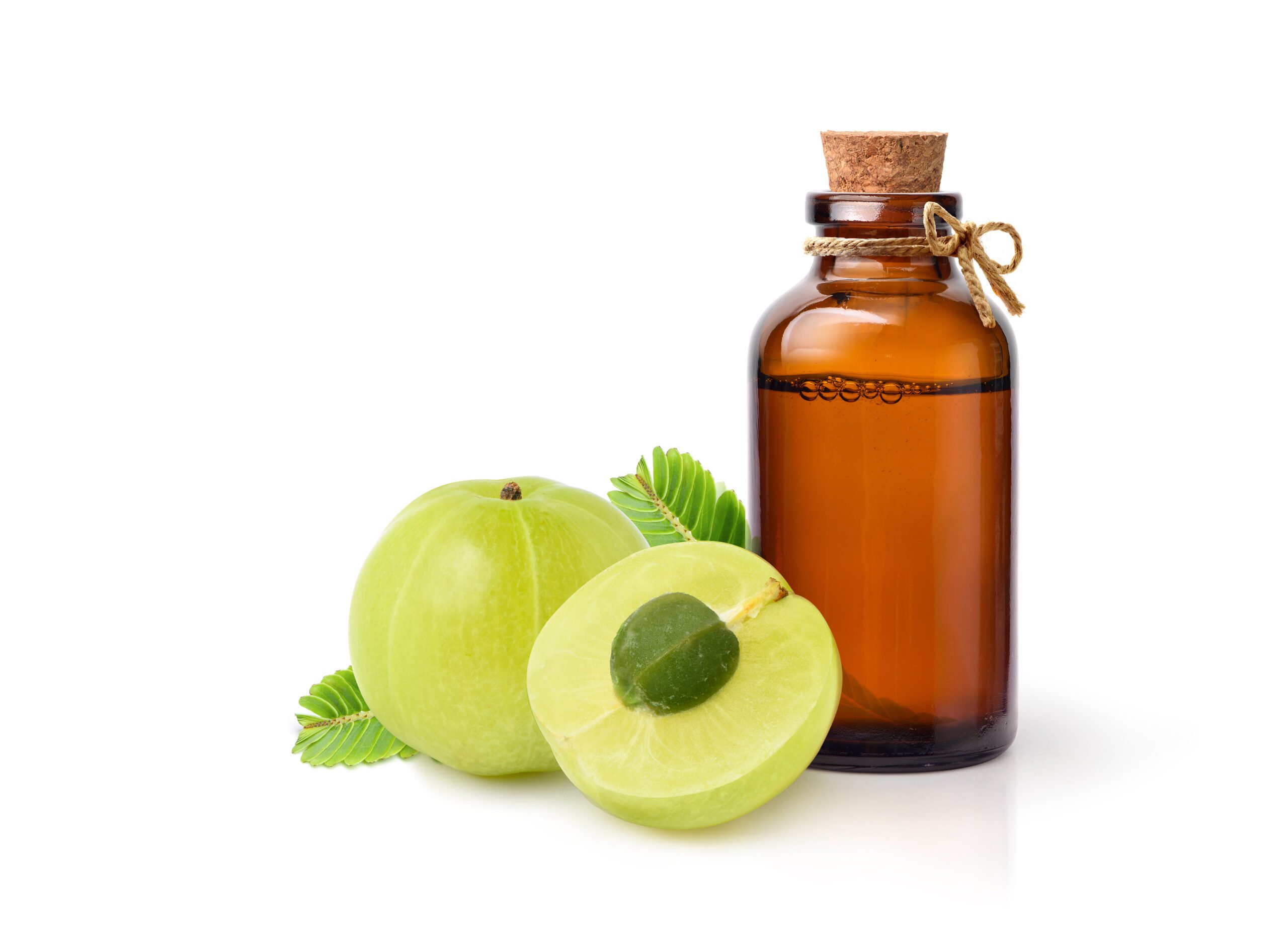
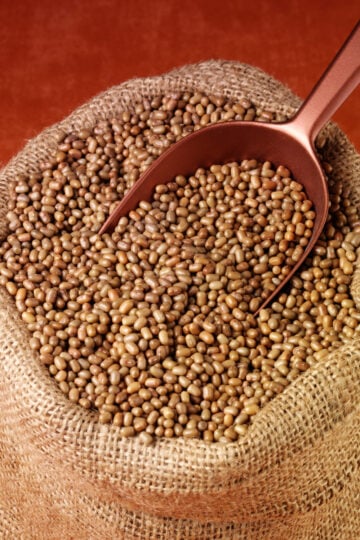
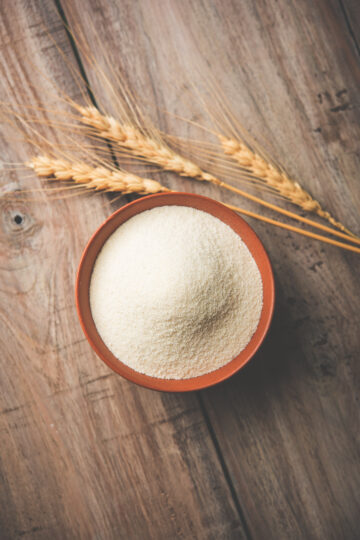
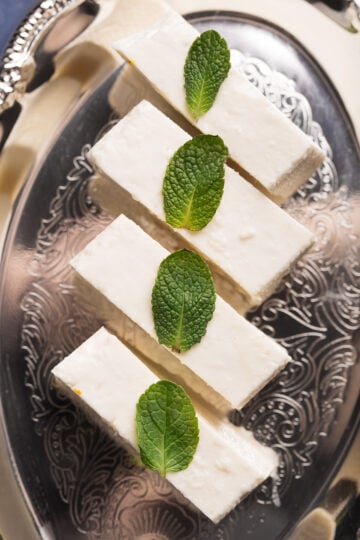
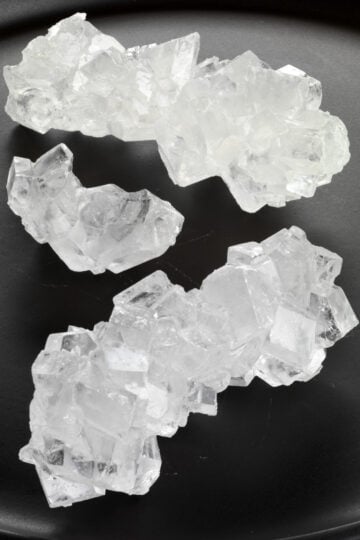
Have a question or something to share? Leave a comment below!